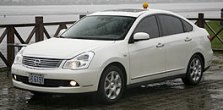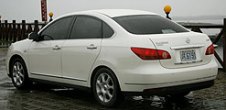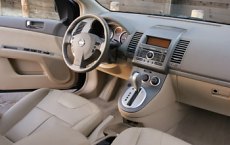|
Nissan Bluebird Sylphy /
Sentra
Debut: 2006
Maker: Nissan
Predecessor: Sunny / Sentra / Almera, also Primera
|
|
Bluebird Sylphy
 The
nameplate Bluebird started in 1959 and entered the 12th generation last
year. For most of the time, it was a mid-size family saloon targeting
at the same crowd as Toyota Corona, Honda Accord and Mitsubishi Galant.
While never being outstanding, it was well received in Japan and
started getting known by European since Nissan started producing it in
Sunderland of UK in the early 1980s. Unfortunately, in the late 1980s
Japan got into economy depression (which would last more than a
decade), dragging Nissan into the edge of bankruptcy. To cut costs, new
boss Carlos Ghosn decided to eliminate excessive models. One of the
victims was the Bluebird. From 2000, its nameplate could only survive
in the form of "Bluebird Sylphy" and sticked to the body of a lightly
revamped Sunny, which is a full class smaller than Bluebird used to be.
At the same time, the Bluebird's positions in the America and Europe
were replaced by Altima and Primera respectively. People started
forgetting this once important Nissan mid-range car... The
nameplate Bluebird started in 1959 and entered the 12th generation last
year. For most of the time, it was a mid-size family saloon targeting
at the same crowd as Toyota Corona, Honda Accord and Mitsubishi Galant.
While never being outstanding, it was well received in Japan and
started getting known by European since Nissan started producing it in
Sunderland of UK in the early 1980s. Unfortunately, in the late 1980s
Japan got into economy depression (which would last more than a
decade), dragging Nissan into the edge of bankruptcy. To cut costs, new
boss Carlos Ghosn decided to eliminate excessive models. One of the
victims was the Bluebird. From 2000, its nameplate could only survive
in the form of "Bluebird Sylphy" and sticked to the body of a lightly
revamped Sunny, which is a full class smaller than Bluebird used to be.
At the same time, the Bluebird's positions in the America and Europe
were replaced by Altima and Primera respectively. People started
forgetting this once important Nissan mid-range car...
However, fate is always changing. A couple of years ago, Nissan dumped
the Sunny nameplate and replaced it with Tiida. The latter is based on
the smaller and cheaper Nissan-Renault B-platform (i.e. Cube, Note,
Clio, Modus etc.) thus leaves a space for a larger and more expensive
model inserting below Teana / Cefiro / Altima. Nissan Renault's
C-platform (i.e. Megane, Scenic) would fit this purpose. By extending
its wheelbase from Megane's 2625mm to 2700mm and by adding a boot to
extend its overall length to 4.6 meters, the new Nissan has all the
ingredients of the traditional Bluebird. In this way, the real Bluebird
is back.
 A
glance from outside will find the new Bluebird Sylphy seems like a
smaller version of Teana, as they share the same design theme. There is
an upmarket visual quality in it, but you may also criticize it for
being too conservative. The design is obviously inspired by the last
generation Volkswagen Passat and I can't see any special new ideas. The
same story goes for the interior. Open the doors and you will see a
well finished environment - the materials are reasonably high quality
(well, don't expect top notch quality in Carlos Ghosn era) and there is
faux wood inserts that look like real woods. Nevertheless, the design
of the dashboard and console is so ugly that we must question the taste
of Nissan's interior designers. It degrades the otherwise fine visual
quality. A
glance from outside will find the new Bluebird Sylphy seems like a
smaller version of Teana, as they share the same design theme. There is
an upmarket visual quality in it, but you may also criticize it for
being too conservative. The design is obviously inspired by the last
generation Volkswagen Passat and I can't see any special new ideas. The
same story goes for the interior. Open the doors and you will see a
well finished environment - the materials are reasonably high quality
(well, don't expect top notch quality in Carlos Ghosn era) and there is
faux wood inserts that look like real woods. Nevertheless, the design
of the dashboard and console is so ugly that we must question the taste
of Nissan's interior designers. It degrades the otherwise fine visual
quality.
Fortunately, the long wheelbase gives the cabin plenty of space.
Looking around, only Honda Civic provides the same 2700mm wheelbase,
while most other rivals measure around 2600mm. No wonder the Nissan
offers a class-leading 680mm of rear legroom. It also provides a lot of
storage spaces. In particular, the storage box between the front seats
is so long and deep that it can swallow a briefcase or box file, very
convenient. On the downside, the rear seat backrest cannot fold down to
increase luggage volume. Admittedly, the boot measures a massive 504
liters, matches a Mercedes E-class, thus you rarely need any more space.
On the run, the cabin is well insulated from noise sources. The
powertrain comprises of 2-liter engine and Xtronic CVT is smooth and
refined in typical Japanese style. Codenamed MR20DE, the new engine
replaces the long-serving QR20DE as Nissan's mainstream four-cylinder
engine. Rated at 133ps (JIS) only, it is by no means a hot performer.
Instead, it emphasizes fuel economy and low-rev torque. The former is
achieved by applying micro-finish treatment to the reciprocating parts
to reduce 30% friction, while the latter is implemented by installing
continuous variable valve timing to enable 90% of maximum torque
available from 2000rpm upward. Overall, this is a decent powerplant, if
not remarkable.
 The
Xtronic CVT is produced by Jatco, formerly the transmission division of
Nissan. It provides a sport mode which keeps rev at higher level but is
absence of any manual-simulated mode. When you press throttle, the
engine rev increases until around 4000 rpm, where it settles there to
take advantage of the engine's highest torque. The transmission ratio
varies to keep the rev constant while the car is accelerating
gradually. We call this loose relationship between engine rev (hence
noise) and vehicle speed as "rubber band effect". Although rubber band
effect does not harm acceleration, it is a displeasure to keen drivers
because the engine rev and noise fails to feedback the driver's
throttle input. The Xtronic CVT shows less rubber band effect than
older generations of CVTs, but as long as manual mode is not offered,
the rubber band effect will never be eliminated. The
Xtronic CVT is produced by Jatco, formerly the transmission division of
Nissan. It provides a sport mode which keeps rev at higher level but is
absence of any manual-simulated mode. When you press throttle, the
engine rev increases until around 4000 rpm, where it settles there to
take advantage of the engine's highest torque. The transmission ratio
varies to keep the rev constant while the car is accelerating
gradually. We call this loose relationship between engine rev (hence
noise) and vehicle speed as "rubber band effect". Although rubber band
effect does not harm acceleration, it is a displeasure to keen drivers
because the engine rev and noise fails to feedback the driver's
throttle input. The Xtronic CVT shows less rubber band effect than
older generations of CVTs, but as long as manual mode is not offered,
the rubber band effect will never be eliminated.
Like Renault Megane, the chassis of Bluebird Sylphy rides on
semi-independent torsion-beam rear suspension while steering is
assisted electrically. Predictably, in the Japanese car the suspension
setup biases towards the soft side. All controls are set to be
lightweight. On the road, the car rolls quite a lot in corners,
although grip and balance are okay. The super-light steering lacks feel
and confidence, as is the lightweight throttle. This car gives so
little feedback to the driver thus is by no means a driver's car.
Moreover, the brakes - still drums at the rear - are weak in power.
Overall speaking, the return of Bluebird is not an applause to me.
While it is better than the Sunny-based last generation, it is not an
outstanding product in terms of interior design, quality and driver
appeal. However, few people will care about this, because the car is
available only in its home market, China and Taiwan etc. |
| The
above report was last updated on 13 Jan
2007. All Rights Reserved. |
Sentra
|
 Sentra
is the sister car of
Bluebird Sylphy. While Bluebird Sylphy is designed for Japanese and
Asian, Sentra is destined to North America. To ensure it suits the
taste of American, it was designed in the California studio and built
in the Mexico plant. That's why it looks so much different from its
Japanese sister. While Bluebird Sylphy looks polite and
executive-class-like, the Sentra looks bold and funky. There is some
European flavours in its design, such as the tall and short boot, the
high shoulder line and strong C-pillars. Overall speaking, this is not
a memorable design, but it is by no means dull, unlike the recent
Toyota Corolla and Hyundai Elantra. Sentra
is the sister car of
Bluebird Sylphy. While Bluebird Sylphy is designed for Japanese and
Asian, Sentra is destined to North America. To ensure it suits the
taste of American, it was designed in the California studio and built
in the Mexico plant. That's why it looks so much different from its
Japanese sister. While Bluebird Sylphy looks polite and
executive-class-like, the Sentra looks bold and funky. There is some
European flavours in its design, such as the tall and short boot, the
high shoulder line and strong C-pillars. Overall speaking, this is not
a memorable design, but it is by no means dull, unlike the recent
Toyota Corolla and Hyundai Elantra.
 Like Bluebird Sylphy,
Sentra is derived from Renault-Nissan's
C-platform, which started life in the current Renault Megane. It
therefore shares high percentage of components with its Japanese
sister, such as the same strut and torsion-beam suspensions, electric
power steering, MR20DE engine and Xtronic CVT. Nevertheless, today's
platform sharing technology is much more flexible than the last
generation. It allows the cars to employ different wheelbases and
widths, not just different heights and lengths of overhangs. In the
case of Sentra, it uses a unique wheelbase at 2685mm. Though this is
15mm shorter than Bluebird's, it is still one of the longest in the
class and ensures plenty of rear legroom. Moreover, without limited by
the Japanese tax boundary, the body width can be stretched from the
Bluebird's 1695mm to 1790mm. No wonder the Sentra can easily fit 3
adults at the back. Without the extra width, people would have
questioned what advantages it has over the smaller Tiida / Versa, whose
sliding rear bench already offers enormous legroom. Like Bluebird Sylphy,
Sentra is derived from Renault-Nissan's
C-platform, which started life in the current Renault Megane. It
therefore shares high percentage of components with its Japanese
sister, such as the same strut and torsion-beam suspensions, electric
power steering, MR20DE engine and Xtronic CVT. Nevertheless, today's
platform sharing technology is much more flexible than the last
generation. It allows the cars to employ different wheelbases and
widths, not just different heights and lengths of overhangs. In the
case of Sentra, it uses a unique wheelbase at 2685mm. Though this is
15mm shorter than Bluebird's, it is still one of the longest in the
class and ensures plenty of rear legroom. Moreover, without limited by
the Japanese tax boundary, the body width can be stretched from the
Bluebird's 1695mm to 1790mm. No wonder the Sentra can easily fit 3
adults at the back. Without the extra width, people would have
questioned what advantages it has over the smaller Tiida / Versa, whose
sliding rear bench already offers enormous legroom.
Being
a 3-box, the
Sentra fails to match hatchbacks for loading convenience and
flexibility. However, what really disappoints is the short of luggage
capacity – the short trunk measures just 371 liters, no better than
most hatchbacks. If there were any advantages of its 3-box design,
sorry, I can't see.
 The packaging of cabin is
another source of criticism, if in a lesser
degree. Despite of a so-called upgrade in materials, you can still find
the dash top, grab handles and armrest are made of hard plastics. The
door trims look cheap. The cloth seats are plain. The fake alloy center
console is just too fake. The center LCD is monochrome only and
unreadable under sunlight through a polarized screen. Carlos Ghosn once
said today's customers ask for good-looking materials, textures and
colors in cabin design, so why doesn't his latest mainstream car
deliver the promise ? unquestionably, in terms of style, quality and
attention to details, the cabin of Sentra falls short of the standard
set by European hatchbacks, Toyota Corolla and Honda Civic. It is
barely better than the Korean offerings. The packaging of cabin is
another source of criticism, if in a lesser
degree. Despite of a so-called upgrade in materials, you can still find
the dash top, grab handles and armrest are made of hard plastics. The
door trims look cheap. The cloth seats are plain. The fake alloy center
console is just too fake. The center LCD is monochrome only and
unreadable under sunlight through a polarized screen. Carlos Ghosn once
said today's customers ask for good-looking materials, textures and
colors in cabin design, so why doesn't his latest mainstream car
deliver the promise ? unquestionably, in terms of style, quality and
attention to details, the cabin of Sentra falls short of the standard
set by European hatchbacks, Toyota Corolla and Honda Civic. It is
barely better than the Korean offerings.
 Having spent so many words
on its packaging, it's time to see how it
drives. We start from the powertrain. MR20DE is a modern engine with
all-alloy construction and intake continuous variable valve timing.
Although it is neither as powerful nor as frugal as Volkswagen's 2.0
FSI engine, it is smooth and gusty enough. Even smoother is the Xtronic
CVT for which most buyers will opt. However, like all CVTs, the loose
relationship between rev and acceleration takes some getting used to,
and it is never the choice of a keen driver (never mind, as the car is
neither a keen driver's choice). Another transmission is a 6-speed
manual. Unfortunately, its gearshift is rubbery and the clutch pedal
feels numb, so it fails to engage keen drivers too. Having spent so many words
on its packaging, it's time to see how it
drives. We start from the powertrain. MR20DE is a modern engine with
all-alloy construction and intake continuous variable valve timing.
Although it is neither as powerful nor as frugal as Volkswagen's 2.0
FSI engine, it is smooth and gusty enough. Even smoother is the Xtronic
CVT for which most buyers will opt. However, like all CVTs, the loose
relationship between rev and acceleration takes some getting used to,
and it is never the choice of a keen driver (never mind, as the car is
neither a keen driver's choice). Another transmission is a 6-speed
manual. Unfortunately, its gearshift is rubbery and the clutch pedal
feels numb, so it fails to engage keen drivers too.
Turn the Sentra into bends, you get little feel from the steering wheel
other than a strong artificial self-centering force. Not a surprise for
an electrical assistance system. At the same time, the Sentra rolls a
lot due to its civilized suspension setting. Hit a bump at speed
transmits shocks to the cabin instantly, a hint of poor damping. Hit
the brake pedal, and the combination of front discs / rear drums
braking system takes a life to stop the car. So it's enough for road
test. Apparently, this is not a driver's car. In fact, it is one of the
dullest drives in the class.
Failing to catch our hearts in dynamics, looks and packaging, Sentra is
easily forgettable in a class crowded with so many good cars.
|
| The
above report was last updated on 2 Feb 2007. All
Rights Reserved. |
Sentra SE-R Spec V
|
 Since
1991, Nissan calls the hot version of Sentra as SE-R and the hottest
version as SE-R Spec V. This tradition remains unchanged in the latest
generation. Both cars are powered by a large-capacity four-cylinder
engine, codenamed QR25DE. Twin-balancer shafts help smoothening the
vibration generated from the 2488 cc engine, while variable valve
timing keeps efficiency high. The engine produces 177 horsepower in
SE-R and 200 horsepower in the Spec V. The latter is achieved with a
higher, 10.5:1 compression (which requires premium fuel), smoother
intake and exhaust manifolds, hotter cam profile and reinforced
reciprocating parts. Since
1991, Nissan calls the hot version of Sentra as SE-R and the hottest
version as SE-R Spec V. This tradition remains unchanged in the latest
generation. Both cars are powered by a large-capacity four-cylinder
engine, codenamed QR25DE. Twin-balancer shafts help smoothening the
vibration generated from the 2488 cc engine, while variable valve
timing keeps efficiency high. The engine produces 177 horsepower in
SE-R and 200 horsepower in the Spec V. The latter is achieved with a
higher, 10.5:1 compression (which requires premium fuel), smoother
intake and exhaust manifolds, hotter cam profile and reinforced
reciprocating parts.
The engine in SE-R is mated to Xtronic CVT and very ordinary suspension
/ brakes / tires etc., so it does not raise our interest. Instead, we
shall focus on the Spec V, which received tower braces to reinforce the
suspensions, 225/45WR17 tires to enhance grip, helical limited slip
differential to enhance cornering traction, larger front brakes to
improve stopping power and stiffer suspension setup to sharpen
handling. Moreover, its 6-speed manual gearbox should be the driver's
choice. In this car, the gearshift works more precisely than in the
regular Sentra 2.0S. The engine also provides sufficient punch,
although bottom-end torque is not as strong as we predicted for a big
four-banger. Look at the torque curve and you know why: the max torque
of 180 lbft arrives at a rather high 5200 rpm. It might be more
accessible than Honda Civic Si / Type R, but it can't match the
instantaneous stream of torque provided by turbocharged European hot
hatches. Luckily, in the North America Sentra SE-R Spec V (what a long
name !) only needs to face Volkswagen Golf GTI.
The handling is good – up to a point. Nissan said it was tested in
Nurburgring by the same test driver as Skyline GT-R R32 / R33. Yes, it
has strong grip and predictable handling, but when its name is attached
with "Spec V", we expect sharper steering (the electric power steering
is too numb), tighter body control, better balance and less understeer.
On the plus side, torque steer is not too severe in the LSD-equipped
car, partly thanks to the weak bottom-end torque. Nissan reserved too
much ride comfort for the Spec V, making it less a real fighter to
Honda. However, neither can present a real threat to Golf GTI, whose
perfect combination of entertainment and refinement is yet to be
matched. |
| The
above report was last updated on 6 Mar 2007. All
Rights Reserved. |
|
|